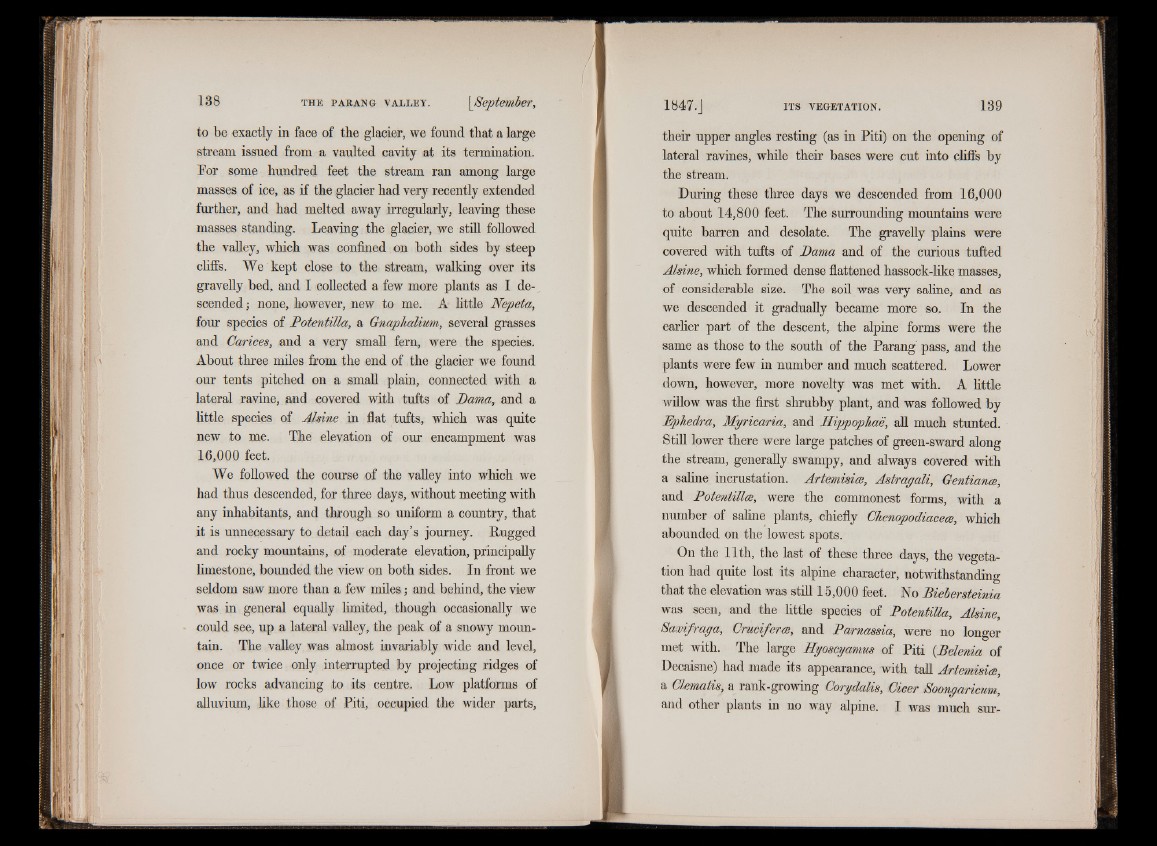
to be exactly in face of the glacier, we found that a large
stream issued from a vaulted cavity at its termination.
For some hundred feet the stream ran among large
masses of ice, as if the glacier had very recently extended
further, and had melted away irregularly, leaving these
masses standing. Leaving the glacier, we still followed
the valley, which was confined on both sides by steep
cliffs. We kept close to the stream, walking over its
gravelly bed, and I collected a few more plants as I descended;
none, however, new to me. A little Nepeta,
four species of Potentilla, a Gnaphalium, several grasses
and Carices, and a very small fern, were the species.
About three miles from the end of the glacier we found
our tents pitched on a small plain, connected with a
lateral ravine, and covered with tufts of Darna, and a
little species of Alsine in flat tufts, which was quite
new to me. The elevation of our encampment was
16,000 feet.
We followed the course of the valley into which we
had thus descended, for three days, without meeting with
any inhabitants, and through so uniform a country, that
it is unnecessary to detail each day’s journey. Rugged
and rocky mountains, of moderate elevation, principally
limestone, bounded the view on both sides. In front we
seldom saw more than a few miles; and behind, the view
was in general equally limited, though occasionally we
could see, up a lateral valley, the peak of a snowy mountain.
The valley was almost invariably wide and level,
once or twice only interrupted by projecting ridges of
low rocks advancing to its centre. Low platforms of
alluvium, like those of Piti, occupied the wider parts,
their upper angles resting (as in Piti) on the opening of
lateral ravines, while their bases were cut into cliffs by
the stream.
During these three days we descended from 16,000
to about 14,800 feet. The surrounding mountains were
quite barren and desolate. The gravelly plains were
covered with tufts of Dama and of the curious tufted
Alsine, which formed dense flattened hassock-like masses,
of considerable size. The soil was very saline, and as
we descended it gradually became more so. In the
earlier part of the descent, the alpine forms were the
same as those to the south of the Parang' pass, and the
plants were few in number and much scattered. Lower
down, however, more novelty was met with. A little
willow was the first shrubby plant, and was followed by
Ephedra, Myricaria, and Hippophae, all much stunted.
Still lower there were large patches of green-sward along
the stream, generally swampy, and always covered with
a saline incrustation. Artemisia}, Astragali, Gentiana,
and Potentilla, were the commonest forms, with a
number of saline plants, chiefly Chenopodiacece, which
abounded on the lowest spots.
On the 11th, the last of these three days, the vegetation
had quite lost its alpine character, notwithstanding
that the elevation was still 15,000 feet. No Biebersteinia
was seen, and the little species of Potentilla, Alsine,
Saxífraga, Crucifera, and Parnassia, were no longer
met with. The large Hyoscyamus of Piti {Belenia of
Decaisne) had made its appearance, with tall Artemisia,
a Clematis, a rank-growing Corydalis, Cicer Soongaricum,
and other plants in no way alpine. I was much sur